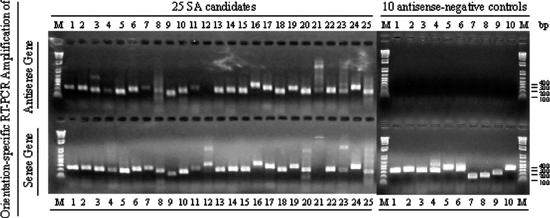Figure 2.

Assessment of transcriptional directionality by orientation-specific RT–PCR. SA-1 to SA-25 are 25 randomly selected human SA candidates, and NC-1 to NC-10 are 10 negative controls (see Materials and Methods). A 1.5% agarose gel was used for RT–PCR product checking, and ‘1 kb Plus DNA Ladder’ (Invitrogen) was used as DNA molecular weight marker (M). For each candidate or negative control, four RT–PCR reactions were carried out (see Materials and Methods). All the positive controls were detected as positive and all the negative controls were detected as negative (data not shown). Except for SA-12, 24 out of the 25 SA candidate primer sets and no negative control primer sets were positive for antisense transcription over the regions queried. Of these 24 sets, 23 were also positive for sense transcription, except for SA-21. All the 10 negative controls were positive only for their sense transcription, not for antisense transcription. In addition, only one of the SA candidate genes (i.e. the antisense gene of the SA-6 pair; NM_002643) was included in Yelin et al.'s (14) micro-array data set; it was not detected by their micro-array, but was detected by our RT–PCR. In addition, sense gene (NM_003275) of the SA-15 and antisense gene (NM_032622) of the SA-17 were also included in Shendure and Church's (13) RT–PCR analysis, and both of them were detected as positive in both RT–PCR analyses.
